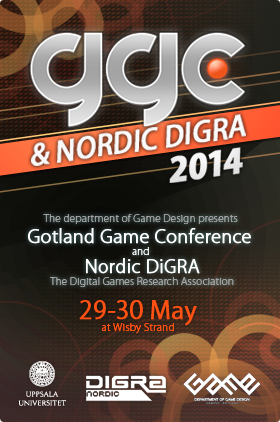The Digital Games Research Association is the premiere international association for academics and professionals who research digital games and associated phenomena.
This year, Nordic DiGRA is teaming up with Gotland Game Conference on the paradise island in the baltic sea. Running along side GGC, we will be showcasing papers on the subject of Gamification and how game systems are becoming more pervasive in every day life.
Innovation and transformation at GGC, Gamification and application of design at DiGRA Nordic.
Thursday 29/5
11:00 – 12:30 Session 1:
- Devil’s Plaything: On the Boundary between Playful and Serious
Kristine Jørgensen - Player and Figure: An Analysis of a Scene in Kentucky Route Zero
Daniel Vella - Ludology, Narratology and Philosophical Hermeneutics
Jonne Arjoranta and Veli-Matti Karhulahti
16:00 – 17:30 Session 2:
- Material Culture and Angry Birds
Heikki Tyni and Olli Sotamaa - It’s Hard to Play in the Trenches: World War I in Videogames
Adam Chapman - Free-to-Play Games: Professionals’ Perspectives
Kati Alha, Elina Koskinen, Janne Paavilainen, Juho Hamari and Jani Kinnunen
DiGRA ABSTRACTS
Devil’s Plaything: On the Boundary between Playful and Serious
Kristine Jørgensen
With point of departure in the concepts of positive negative experiences (Hopeametsä 2008; Montola 2010), deep play (Geertz, 1973, 432-433; Schechner 2013, 118-119), brink play (Poremba 2007), and the bleed effect (Montola 2010; Waern 2010), this paper discusses how games tackle serious and controversial issues in the context of play. The paper’s central argument is that seriousness is not only possible in games and play, but that seriousness is a prerequisite and a necessary aspect of all play activities.
Player and Figure: An Analysis of a Scene in Kentucky Route Zero
Daniel Vella
Discussions of the relation between the player and the figure under her control have identified a duality between the figure as ‘avatar’ and ‘character’. This paper argues that two separate dualities are being conflated: an ontological duality in the figure, by which it is both self and other for the player, and a duality in the player’s relation to it, which can be both subjective and objective. This insight is used as the basis for developing a two-axis model that identifies four aspects to the player-figure relation. This model is then put to work on a close analysis of a scene in Kentucky Route Zero (Cardboard Computer 2013), which will serve to demonstrate the dimensions of the player-figure relation.
Ludology, Narratology and Philosophical Hermeneutics
Jonne Arjoranta and Veli-Matti Karhulahti
In this article we present the hermeneutic method as a tool for analyzing game studies discourses. We use Markku Eskelinen’s profusely interpreted “The Gaming Situation” (2001) as a case study. Our premise is that whereas the hermeneutic method is academically well-established, its conscious application is not. It is suggested that with conscious application of the hermeneutic method the persistent and problematic questions in game studies, like those related to narrative, definition, and art, gain potential to be treated with increased sophistication.
Material Culture and Angry Birds
Heikki Tyni and Olli Sotamaa
The article examines different ways in which the research of material culture is relevant for digital games. It is argued that despite the wide adoption of digital distribution, material culture still registers as a significant component of the overall gaming culture. The paper compiles a collection of different research areas relevant for the study of games and materiality. In order to better contextualize the different research approaches, the framework is applied to Angry Birds (Rovio 2009). The different approaches, ranging from platform studies and political economy to merchandizing and collecting, highlight how a seemingly small, digitally distributed mobile game still manages to connect with multiple facets of material culture in significant ways.
It’s Hard to Play in the Trenches: World War I in Videogames
Adam Chapman
World War I (WWI) has a relatively unusual presence in popular memory and historical videogames have rapidly become one of the most successful forms of popular history. Despite this, there is very little research that examines the representation of WWI in videogames. This article provides an overview of WWI games, organising them by genre and determining their engagement with WWI popular memory. Secondly, the article explains the issues that face videogames in trying to engage this memory, particularly given its relatively controversial and contested nature. Thirdly, using frame analysis, the article suggests a number of reframings which videogames that engage with WWI popular memory seem to use to negotiate these issues. Accordingly, the analysis reveals the nature of depictions of WWI that players are exposed too in this new popular form. Furthermore, in doing so, the current limitations and possibilities of videogames as a historical form are further explored.
Free-to-Play Games: Professionals’ Perspectives
Kati Alha, Elina Koskinen, Janne Paavilainen, Juho Hamari and Jani Kinnunen
This paper investigates the free-to-play revenue model from the perspective of game professionals. To court larger player audiences and to address their wide willingness-to-pay spectrum, game developers have increasingly adopted the free-to-play revenue model. However, at the same, worrying concerns over the revenue model have been voiced. For example, free-to-play games have been deemed as exploitative and unethical. We investigated this contrast by conducting a thematic interview study. We employed grounded theory in the analysis of the data containing 14 game professionals’ interviews about their views on the free-to-play model. The results show, that the free-to-play model is something that the developers view favorably while the public writing about the games can even be hostile. The games have evolved, while the voiced opinions still talk about games of the beginning of the model. Relatively few ethical problems were seen that would address the whole model, and the future of the free-to-play games was seen bright.
Organizing Committee
- Ulf Benjaminsson
- Petri Lankoski
- Harko Verhagen

